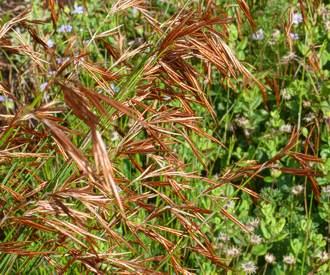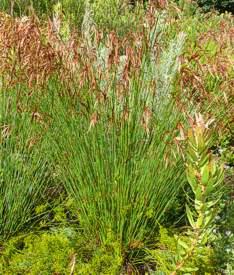Thamnochortus lucens
Thamnochortus lucens (Poir.) H.P.Linder
Family: Restionaceae
Common names: jackal-tail restio (Eng.); jakkalsstert (Afr.)
Introduction
This perennial dwarf restio is a plant that will add some dazzle to your garden. The inflorescences are a shiny bronze colour, guaranteed to catch your eye as you walk by.

Description
Description
Thamnochortus lucens is a restio with an arching, tufted growth habit which remains rounded, compact and neat It is 0.3 to 0.6 m tall and has a base diameter of 5-200 mm and a crown diameter of 200-300 mm. It has unbranched, smooth culms (stems) and side shoots often emerge from the nodes along the fertile culms as well as at the base of the plant. These small shoots become curled and tangle together but are sterile as they do not produce flowers or seeds.


Restios occur as separate male and female plants (dioecious). This can make matching the sexes of the same species quite difficult. A good way to tell is to look at the sheaths found along the culms, male and female sheaths will always be the same for both plants. Thamnochortus lucens has persistent sheaths which are very long and tightly wrapped around the culm. At the base they are tan/brown, becoming lighter towards the margins. The upper part of the sheath becomes membranous and frays with age.

The male inflorescence is pendulous and has many spikelets (flower heads) per culm. The spikelets are 40-130 x 20-55 mm. The male flowers are inside the spikelet. Female inflorescences are 20-130 x 10-30 mm, upright and a darker brown than the bronze-coloured male spikelets. Bracts for males and females are papery and much longer than the flowers. Small brown flowers appear within the inflorescence from March to May (autumn). The winged brown seeds, 1.4-2.0 mm in diameter, are released in June.
Conservation Status
Status
This plant is currently not threatened due to its wide distribution range.
Distribution and habitat
Distribution description
Thamnochortus lucens has a large distribution range within the Western and Northern Cape. It occurs from Saldanha, down along the west coast all the way to the Cape Peninsula as well as from Tulbagh to Riviersonderend and Hermanus. It is commonly found on the Western Cape mountains.
This fynbos species is locally dominant and found in small populations. It grows on dry, sandstone mountain slopes at altitudes of 5-1525 m. The soil type is stony and well drained. Winter rainfall is experienced along with hot, dry summers.
Derivation of name and historical aspects
History
The Restionaceae family contains about 28 genera and 400 species. They are mostly confined to the southern hemisphere although one species occurs in Vietnam. Restionaceae comes from a Latin word, restis, and means cord or rope.
The genus Thamnochortus originates from the Greek words, thamno, meaning bush, and chortus, meaning green herbage. There are about 33 species of Thamnochortus with most of them occurring in the Western Cape, and a few in the Eastern Cape. The Latin word lucens is derived from lucidus, meaning a shining or polished surface, alluding to the bronze inflorescences.
Ecology
Ecology
Male restio plants produce lots of pollen as they rely on the wind for pollination. The pollen is blown onto the female style where fertilization takes place and seeds are formed. The seeds are winged, which aids wind dispersal. Thamnochortus lucens is a resprouter and will send up shoots from the base of the plant (rhizome) after fire.
Uses
Use
Thamnochortus lucens is used for display purposes in the restio garden at Kirstenbosch. It was first collected for introduction into the garden in 1975 and has since proved a worthy landscaping plant.

Growing Thamnochortus lucens
Grow
Restios are propagated by seed as this produces a vigorous, well-shaped plant. Dividing mature plants is another method of propagation, although the plant takes about one year to re-establish itself.
Sow seeds in early autumn (March) when there is a fluctuation between day and night temperatures. Night temperatures are cool, 10-15°C, and daytime temperatures warm, 20-30°C. Fifty per cent of restio seeds produced by a plant are not viable. A good germination percentage occurs when the seeds are treated with the Instant Smoke Plus seed primer. Sow the seeds into deep seed trays using a well-drained medium. Sow in an even layer completely covering the growing medium. Cover with a fine layer of milled bark and water lightly. Place the seed trays in a warm light area. Keep the trays damp but not wet. Germination should take place after three weeks.
Once the plants have developed a few small culms, after ± 6-12 weeks, and are 30 mm tall, they can be pricked out into 6-packs or plug trays. Use a fynbos potting medium.
Harden off the plants in a semi-shaded area until they are growing strongly (± 4 weeks) before placing in the sun. Once the roots start to show through the bottom of the trays they can be potted into small black bags. After growing on they will be ready to be planted in the garden.
In the garden Thamnochortus lucens prefers a sunny spot with lots of air movement. It grows in a wide range of soils provided that it has good drainage. Add compost at planting time which should be early winter or at the start of the rainy season. The cooler weather and rain allow the plant to establish deep roots before the onset of the hot, dry summer season. Plant at other times of the year provided that the plant is well watered for the first two months. It is used to hot dry summers with minimal watering, although a more robust, lush plant will be achieved with regular watering.
This restio looks fantastic planted in a fynbos garden, re-creating its natural habitat. Erica cerinthoides, Watsonia borbonica, Leucadendron spissifolium subsp. phillipsii, Lampranthus aureus and Leucospermum cordifolium are a few plants to include. Another idea is to plant Thamnochortus lucens in large sweeps where the wind blowing through the plants creates an eye-catching focal point.
Restios in the garden are relatively free from pests and diseases. They are prone to damping off as seedlings if they are over-watered with little air movement.
References
- Brown, N., Jamieson, H. & Botha, P. 1998. Grow restios. Kirstenbosch Gardening Series. National Botanical Institute, Cape Town.
- Leistner, O.A. (ed.). 2000. Seeds plants of southern Africa : families and genera. Strelitzia 10. National Botanical Institute, Pretoria.
- Linder, H.P. 2006. African Restionaceae 4. CD, Bolus Herbarium, Department of Botany, University of Cape Town, Rondebosch.
- Smith, C.A. 1966. Common names of South African plants. Memoirs of the Botanical Survey of South Africa No. 35.
Credits
Louise Nurrish
Kirstenbosch National Botanical Garden
March 2009
Plant Attributes:
Plant Type: Restio
SA Distribution: Western Cape
Soil type: Sandy, Loam
Flowering season: Autumn
PH: Acid, Neutral
Flower colour: Brown
Aspect: Full Sun
Gardening skill: Average
Special Features:
Horticultural zones







Rate this article
Article well written and informative
Rate this plant
Is this an interesting plant?
Login to add your Comment
Back to topNot registered yet? Click here to register.